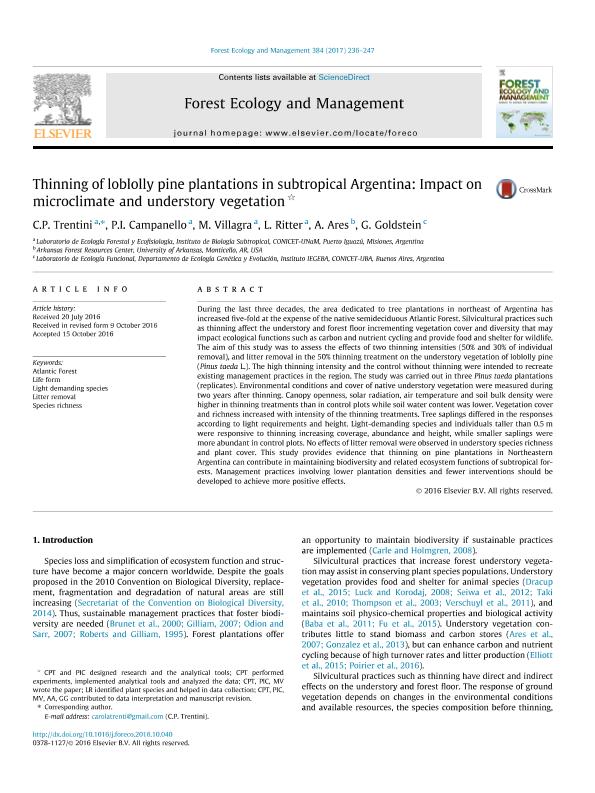Artículo
Thinning of loblolly pine plantations in subtropical Argentina: Impact on microclimate and understory vegetation
Trentini, Carolina Paola ; Campanello, Paula Inés
; Campanello, Paula Inés ; Villagra, Mariana
; Villagra, Mariana ; Ritter, Luis Javier
; Ritter, Luis Javier ; Ares, A.; Goldstein, Guillermo Hernan
; Ares, A.; Goldstein, Guillermo Hernan
 ; Campanello, Paula Inés
; Campanello, Paula Inés ; Villagra, Mariana
; Villagra, Mariana ; Ritter, Luis Javier
; Ritter, Luis Javier ; Ares, A.; Goldstein, Guillermo Hernan
; Ares, A.; Goldstein, Guillermo Hernan
Fecha de publicación:
01/2017
Editorial:
Elsevier Science
Revista:
Forest Ecology and Management
ISSN:
0378-1127
e-ISSN:
0378-1127
Idioma:
Inglés
Tipo de recurso:
Artículo publicado
Clasificación temática:
Resumen
During the last three decades, the area dedicated to tree plantations in northeast of Argentina has increased five-fold at the expense of the native semideciduous Atlantic Forest. Silvicultural practices such as thinning affect the understory and forest floor incrementing vegetation cover and diversity that may impact ecological functions such as carbon and nutrient cycling and provide food and shelter for wildlife. The aim of this study was to assess the effects of two thinning intensities (50% and 30% of individual removal), and litter removal in the 50% thinning treatment on the understory vegetation of loblolly pine (Pinus taeda L.). The high thinning intensity and the control without thinning were intended to recreate existing management practices in the region. The study was carried out in three Pinus taeda plantations (replicates). Environmental conditions and cover of native understory vegetation were measured during two years after thinning. Canopy openness, solar radiation, air temperature and soil bulk density were higher in thinning treatments than in control plots while soil water content was lower. Vegetation cover and richness increased with intensity of the thinning treatments. Tree saplings differed in the responses according to light requirements and height. Light-demanding species and individuals taller than 0.5 m were responsive to thinning increasing coverage, abundance and height, while smaller saplings were more abundant in control plots. No effects of litter removal were observed in understory species richness and plant cover. This study provides evidence that thinning on pine plantations in Northeastern Argentina can contribute in maintaining biodiversity and related ecosystem functions of subtropical forests. Management practices involving lower plantation densities and fewer interventions should be developed to achieve more positive effects.
Palabras clave:
Atlantic Forest
,
Life Form
,
Light Demanding Species
,
Litter Removal
Archivos asociados
Licencia
Identificadores
Colecciones
Articulos(IBS)
Articulos de INSTITUTO DE BIOLOGIA SUBTROPICAL
Articulos de INSTITUTO DE BIOLOGIA SUBTROPICAL
Citación
Trentini, Carolina Paola; Campanello, Paula Inés; Villagra, Mariana; Ritter, Luis Javier; Ares, A.; et al.; Thinning of loblolly pine plantations in subtropical Argentina: Impact on microclimate and understory vegetation; Elsevier Science; Forest Ecology and Management; 384; 1-2017; 236-247
Compartir
Altmétricas



